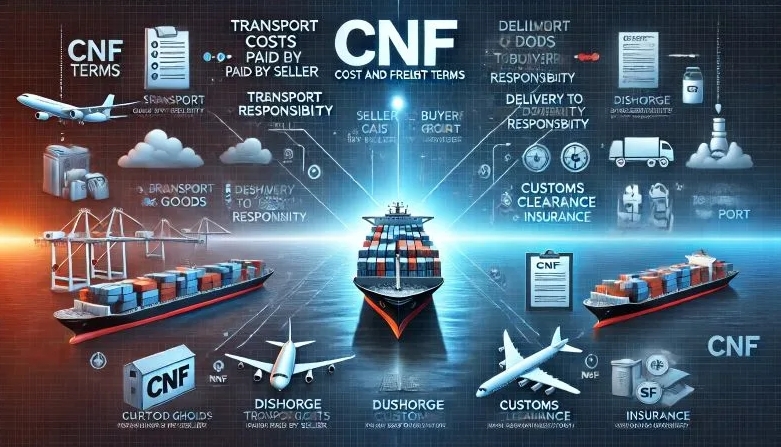The Meaning Of CNF In International Trade
In international trade, trade terms (Incoterms) are an important part of every cross-border transaction that cannot be ignored. CNF (Cost and Freight) is one of the common trade terms in international trade. This article will introduce the meaning of CNF in detail, clarify the rights and responsibilities in the contract, and avoid unnecessary disputes.
Learn more: The 11 common international trade logistics terms
What is CNF
CNF stands for Cost and Freight. This term clarifies the responsibilities, costs and risks that the buyer and seller bear in the transaction process.
According to the CNF terms, the seller shall deliver the goods to the designated means of transport while bearing the costs and freight during the transportation of the goods, and shall be responsible for the transportation costs to the port of destination.
The seller shall bear the costs of transporting the goods to the port of destination, but shall not be responsible for the unloading, import customs clearance, tariffs and other costs of the goods at the port of destination.
Responsibilities and Obligations under CNF Terms
Under the CNF terms, the responsibilities and obligations of the buyer and seller are clearly allocated. Understanding these responsibilities is very important to ensure the smooth progress of the transaction.
The seller’s responsibilities usually include:
- Packaging and marking of goods.
- Transportation costs, including ocean freight.
- Export customs clearance.
The buyer’s responsibilities usually include:
- Unloading costs after arriving at the destination port.
- Import customs clearance and tariffs.
- Transportation costs from the destination port to the final destination.
Advantages and limitations of CNF
Advantages:
- Cost transparency: Under CNF terms, the transportation costs borne by the seller are clear, and the buyer knows what he needs to bear
- Flexibility: The buyer can flexibly arrange cargo insurance according to his own needs, thereby reducing costs.
- Cost-effectiveness: The seller does not need to bear insurance costs and related responsibilities, which helps to simplify the transaction process and improve efficiency.
Limitations:
- Unloading costs at the port of destination are not included: The seller bears the transportation costs, but the unloading costs at the port of destination are borne by the buyer, which may result in additional costs.
- Difficulty in claiming: Since the insurance costs are borne by the buyer and the insurance policy is in the hands of the buyer, the seller may face difficulties in claiming when the goods are lost.
- Responsibility for insurance arrangement: The buyer needs to arrange insurance on his own and have a full understanding of the insurance terms and claims process to avoid potential risks.
How to Calculate CNF Cost?
The calculation formula for CNF pricing is usually:
CNF price = FOB price + ocean freight
The costs are mainly composed of the following costs:
- Cargo cost: including the production cost of the goods, packaging costs, etc.
- Transportation costs: including ocean freight, port fees, container rental fees, insurance costs of transportation vehicles, etc.
- Export customs clearance fees: The seller needs to pay export customs clearance, inspection and quarantine fees, etc.
- Additional costs: including loading fees, port fees at the destination port, etc.
Differences between CNF and Other Trade Terms
FOB (Free on Board)
The main difference between FOB and CNF is how much responsibility the seller bears for transportation costs and risks. Once the goods are loaded on the ship, the seller’s responsibility ends. The buyer bears all risks and must pay for transportation, insurance, and import taxes.
CIF (Cost, Insurance and Freight)
Both CNF and CIF are widely used in ocean shipping, but the main difference between the two is whether insurance is included. The seller bears the cost of the goods, the freight to the destination port, and the insurance during transportation. This provides more security for the buyer because the seller is responsible for insuring the goods.
EXW (Ex Works)
EXW (Ex Works) requires the buyer to bear most of the responsibilities compared to CNF. The buyer is responsible for picking up the goods from the seller and handling all aspects of shipping, export customs clearance, and insurance.
Frequently Asked Questions About CNF Shipping
Can I use CNF for air freight?
The CNF Incoterm is designed specifically for ocean freight or inland waterway shipping. If you are shipping goods by air, you should use other Incoterms such as CPT (Carriage Paid To) or CIP (Carriage and Insurance Paid To).
Does CNF Cover Unloading?
CNF does not cover unloading at the destination port. Once the goods arrive, the buyer must arrange and pay for any unloading costs.
Who chooses a freight forwarder for CNF shipping?
Since the seller is responsible for shipping the goods to the destination port, they usually choose a freight forwarder. However, the buyer can hire a freight forwarder to assist with customs clearance and transportation from the destination port to the final delivery location.
Can I Add Variants to the CNF Incoterm?
It is possible to add variants to the CNF Incoterm. For example, you can negotiate additional terms such as insurance coverage or specific handling instructions (such as loading requirements). However, make sure all variants are clearly stated in the contract to avoid confusion.
Can CNF Work with Letters of Credit?
CNF can be used with Letters of Credit (LC). The seller must provide the bank with all necessary shipping documents, such as bills of lading, in order to receive payment according to the terms of the letter of credit.
As a common international trade term, understanding the differences between CNF terms and other trade terms will help you make more appropriate choices in cross-border transactions and ensure smooth transactions.




